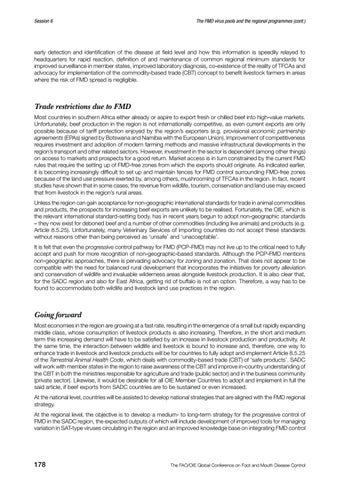Session 6
The FMD virus pools and the regional programmes (cont.)
early detection and identification of the disease at field level and how this information is speedily relayed to headquarters for rapid reaction, definition of and maintenance of common regional minimum standards for improved surveillance in member states, improved laboratory diagnosis, co-existence of the reality of TFCAs and advocacy for implementation of the commodity-based trade (CBT) concept to benefit livestock farmers in areas where the risk of FMD spread is negligible.
Trade restrictions due to FMD Most countries in southern Africa either already or aspire to export fresh or chilled beef into high-value markets. Unfortunately, beef production in the region is not internationally competitive, as even current exports are only possible because of tariff protection enjoyed by the region’s exporters (e.g. provisional economic partnership agreements (EPAs) signed by Botswana and Namibia with the European Union). Improvement of competitiveness requires investment and adoption of modern farming methods and massive infrastructural developments in the region’s transport and other related sectors. However, investment in the sector is dependent (among other things) on access to markets and prospects for a good return. Market access is in turn constrained by the current FMD rules that require the setting up of FMD-free zones from which the exports should originate. As indicated earlier, it is becoming increasingly difficult to set up and maintain fences for FMD control surrounding FMD-free zones because of the land use pressure exerted by, among others, mushrooming of TFCAs in the region. In fact, recent studies have shown that in some cases, the revenue from wildlife, tourism, conservation and land use may exceed that from livestock in the region’s rural areas. Unless the region can gain acceptance for non-geographic international standards for trade in animal commodities and products, the prospects for increasing beef exports are unlikely to be realised. Fortunately, the OIE, which is the relevant international standard-setting body, has in recent years begun to adopt non-geographic standards – they now exist for deboned beef and a number of other commodities (including live animals) and products (e.g. Article 8.5.25). Unfortunately, many Veterinary Services of importing countries do not accept these standards without reasons other than being perceived as ‘unsafe’ and ‘unacceptable’. It is felt that even the progressive control pathway for FMD (PCP-FMD) may not live up to the critical need to fully accept and push for more recognition of non-geographic-based standards. Although the PCP-FMD mentions non-geographic approaches, there is pervading advocacy for zoning and zonation. That does not appear to be compatible with the need for balanced rural development that incorporates the initiatives for poverty alleviation and conservation of wildlife and invaluable wilderness areas alongside livestock production. It is also clear that, for the SADC region and also for East Africa, getting rid of buffalo is not an option. Therefore, a way has to be found to accommodate both wildlife and livestock land use practices in the region.
Going forward Most economies in the region are growing at a fast rate, resulting in the emergence of a small but rapidly expanding middle class, whose consumption of livestock products is also increasing. Therefore, in the short and medium term this increasing demand will have to be satisfied by an increase in livestock production and productivity. At the same time, the interaction between wildlife and livestock is bound to increase and, therefore, one way to enhance trade in livestock and livestock products will be for countries to fully adopt and implement Article 8.5.25 of the Terrestrial Animal Health Code, which deals with commodity-based trade (CBT) of ‘safe products’. SADC will work with member states in the region to raise awareness of the CBT and improve in-country understanding of the CBT in both the ministries responsible for agriculture and trade (public sector) and in the business community (private sector). Likewise, it would be desirable for all OIE Member Countries to adopt and implement in full the said article, if beef exports from SADC countries are to be sustained or even increased. At the national level, countries will be assisted to develop national strategies that are aligned with the FMD regional strategy. At the regional level, the objective is to develop a medium- to long-term strategy for the progressive control of FMD in the SADC region, the expected outputs of which will include development of improved tools for managing variation in SAT-type viruses circulating in the region and an improved knowledge base on integrating FMD control
178
The FAO/OIE Global Conference on Foot and Mouth Disease Control
















